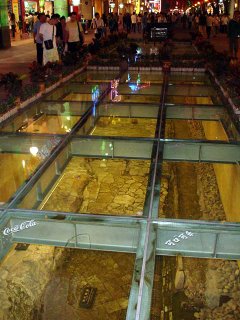 It's time to post again about my Philippine travels. Today, I visited Porac, one of the towns of Pampanga. Although Porac is more known for its natural sites such as Dara and Miyamit Falls as well as the Porac Highlands, it also plays host to some of Pampanga's important cultural heritage structures. One of these is the last intact (meaning unrenovated) hacienda chapel in the province which is located in Barangay Pio.
It's time to post again about my Philippine travels. Today, I visited Porac, one of the towns of Pampanga. Although Porac is more known for its natural sites such as Dara and Miyamit Falls as well as the Porac Highlands, it also plays host to some of Pampanga's important cultural heritage structures. One of these is the last intact (meaning unrenovated) hacienda chapel in the province which is located in Barangay Pio.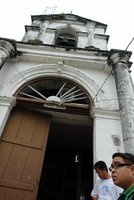 I have been to Pio several times before but we decided to visit today after it had been rumored that someone had purchased the chapel and will be transferring it to Bagac, Bataan! To give you a backgrounder on the Bagac project, check out this PDI column. As a result of the news, the Pio Chapel is fast becoming a rallying point for Pampanga in the fight to preserve its heritage and is now sparking a debate on the ethics of transferring heritage houses and structures.
I have been to Pio several times before but we decided to visit today after it had been rumored that someone had purchased the chapel and will be transferring it to Bagac, Bataan! To give you a backgrounder on the Bagac project, check out this PDI column. As a result of the news, the Pio Chapel is fast becoming a rallying point for Pampanga in the fight to preserve its heritage and is now sparking a debate on the ethics of transferring heritage houses and structures.Heritage structures must remain where they are because they are part of the historical fabric of the communities they are located in. There may be some cases however when transferring a heritage structure may be better than leaving a structure where it is, especially when it is highly likely that the structure will be lost or demolished in the near future.
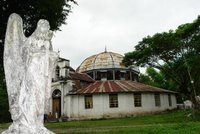 But, when you go shopping for heritage houses and structures, especially in places where they are an important part of the historical fabric of the community, is that right? I was told that many of the houses were purchased from Bulacan, including one from the heritage town of San Miguel de Mayumu (which now serves as the house of Bishop Soc Villegas) and another house in Bustos which was ironically featured in the heritage house calendar of Shell. I wonder if Governor Josie dela Cruz knows about this.
But, when you go shopping for heritage houses and structures, especially in places where they are an important part of the historical fabric of the community, is that right? I was told that many of the houses were purchased from Bulacan, including one from the heritage town of San Miguel de Mayumu (which now serves as the house of Bishop Soc Villegas) and another house in Bustos which was ironically featured in the heritage house calendar of Shell. I wonder if Governor Josie dela Cruz knows about this.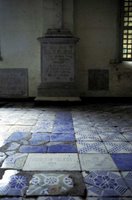 In Pampanga, the grand old Reyes House of Candaba, which was the oldest surviving house in the province and the house where Noli Me Tangere was shot several decades back, is now in Bagac. News circulating is that Mayor Jerry Pelayo is not happy and is making moves to protect what is left.
In Pampanga, the grand old Reyes House of Candaba, which was the oldest surviving house in the province and the house where Noli Me Tangere was shot several decades back, is now in Bagac. News circulating is that Mayor Jerry Pelayo is not happy and is making moves to protect what is left.We got to chat with the parish pastoral council president and a barangay kagawad while we were in Pio. Mass is said at the chapel every Saturday at 5 p.m. It was built in 1861 as part of the hacienda founded by Don Felino Gil (who also founded the Escuela de Artes y Oficios, the oldest trade school in Asia, which is now DHVCAT) and his wife Dona Eugenia Toledo. Their descendants include actress Rosemarie Gil. But the property is no longer theirs since it was sold to someone from Bulacan who was said to have donated the chapel to the local community.
 We were told that the Gils visited several times to cart off the antique furniture and artifacts inside their hacienda house and chapel. Nothing was spared including the piedra china flooring around the chapel and the house. The most infamous of these visits was in the 1980s when actor Dante Varona, who accompanied them, climbed the belfry of the chapel hoping to get the centuries-old bell. He was mobbed by the local community and they were chased away with tabak, an agricultural-based cutting bolo.
We were told that the Gils visited several times to cart off the antique furniture and artifacts inside their hacienda house and chapel. Nothing was spared including the piedra china flooring around the chapel and the house. The most infamous of these visits was in the 1980s when actor Dante Varona, who accompanied them, climbed the belfry of the chapel hoping to get the centuries-old bell. He was mobbed by the local community and they were chased away with tabak, an agricultural-based cutting bolo.The chapel is very important to Pampanga because as I mentioned earlier, it is the only intact visita in the entire province of Pampanga. Aside from that, it is a circular chapel built during the Spanish colonial period, pre-dating the UP Chapel (which some claim to be the first circular church in the country) by 145 years!
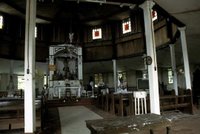 The people of Barangay Pio in Porac are now up in arms after word reached them that their chapel was reportedly sold by a still unknown person and would be transferred to Bagac soon. The municipal government and the local community are now vigilantly guarding the chapel. And if and when the demolition crew comes to get it, they said they will protect it with their lives. Quoting them, "They could not even get the bell, what more the entire chapel!"
The people of Barangay Pio in Porac are now up in arms after word reached them that their chapel was reportedly sold by a still unknown person and would be transferred to Bagac soon. The municipal government and the local community are now vigilantly guarding the chapel. And if and when the demolition crew comes to get it, they said they will protect it with their lives. Quoting them, "They could not even get the bell, what more the entire chapel!"Now with that situation, is it still ethical to transfer a heritage structure to someone's private property? And even more so when news is going around that the structure is being transferred to serve as a decoration for their daughter's debut?
A moratorium on this Bagac project should be done until further studies are done on the location in particular since there are a lot of issues on the safety of the houses being built so close to the sea, and until the heritage community has fully digested this unusual project and threshed out the ethics of transferring heritage structures. Again, heritage structures are best kept where they are so that they are appreciated in the proper context vis-à-vis the environment they are built in.
Actively shopping for heritage houses for use as scrap material for homes or transferring them whole, and even worse, using coffee table books featuring heritage homes as shopping catalogues is simply detestable. The best way to save a heritage house is by educating the local community about the value of a heritage house, the significance of its architecture or former inhabitants to the local community, and its potential as a symbol for the community to strengthen local identity and pride of place.
Photo credits: Tonette T. Orejas (2nd, 3rd and 5th photo)



